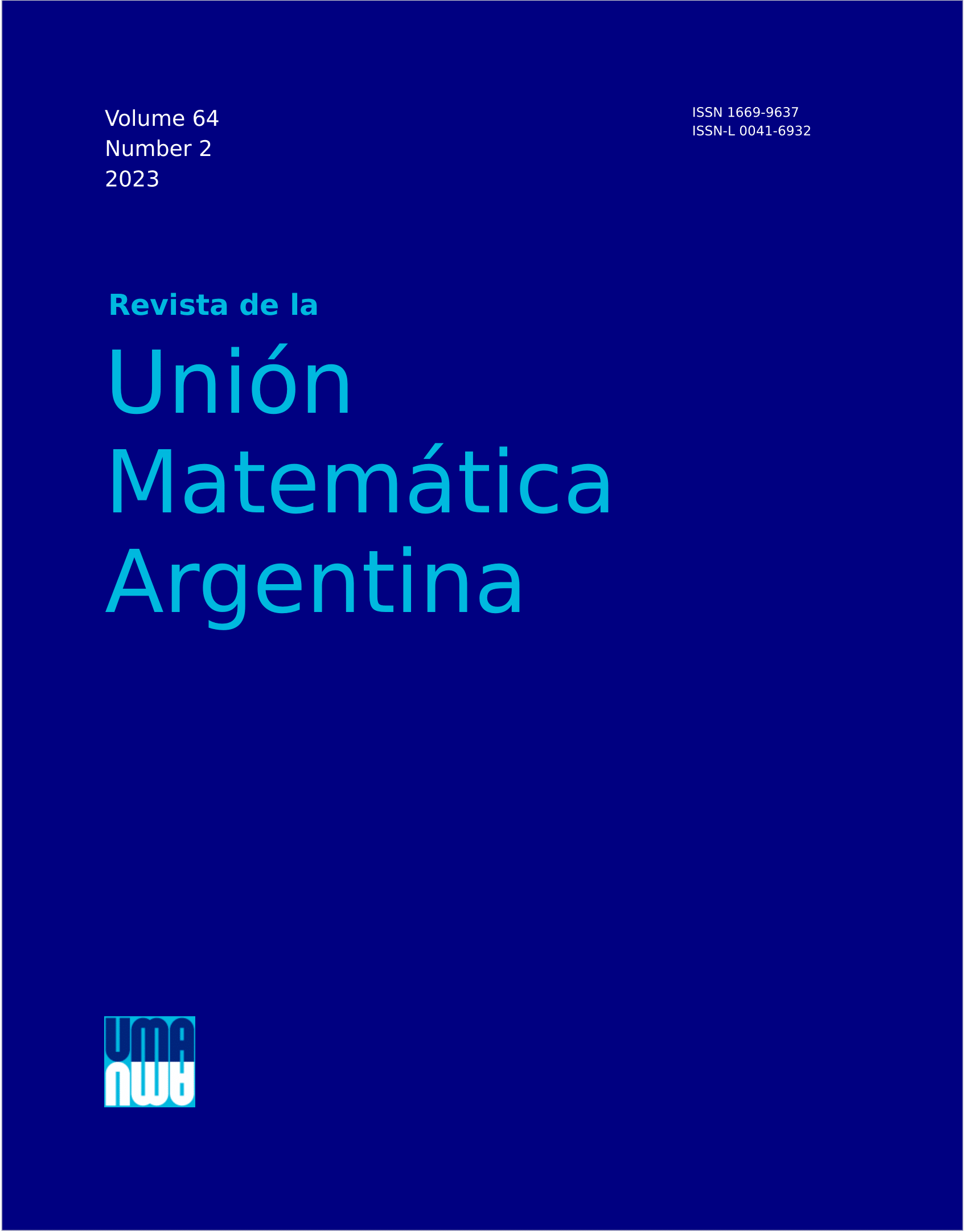A rich and complex dynamics emerges between the subthalamic nucleus and the globus pallidus externa in the basal ganglia
DOI:
https://doi.org/10.33044/revuma.2893Abstract
Oscillatory nature of basal ganglia activity is highly tied with some movement disorders. We study, through bifurcation analysis and computer simulations, the appearance of abnormal oscillations in an already proposed reduced neural circuit model of the subthalamic nucleus and globus pallidus loop. The results show that the model exhibits stable steady states associated to normal activity and oscillatory activity corresponding to the often termed "tremor frequency" oscillations due to their coherence with parkinsonian tremor observed in patients with Parkinson's disease.
Downloads
References
D. Belin and B. J. Everitt, Drug addiction: The neural and psychological basis of a compulsive incentive habit, in Handbook of Basal Ganglia Structure and Function, 571–592, Handbook of Behavioral Neuroscience, 20, Elsevier, 2010.
V. S. Chakravarthy and P. P. Balasubramani, Basal ganglia system as an engine for exploration, in Encyclopedia of Computational Neuroscience, 315–327, Springer New York, 2015, https://doi.org/10.1007/978-1-4614-7320-6_81-1.
V. S. Chakravarthy and P. P. Balasubramani, The basal ganglia system as an engine for exploration, in Computational Neuroscience Models of the Basal Ganglia, 59–96, Springer Singapore, 2018, https://doi.org/10.1007/978-981-10-8494-2_5.
A. Dhooge, W. Govaerts, and Yu. A. Kuznetsov, MATCONT: a MATLAB package for numerical bifurcation analysis of ODEs, ACM Trans. Math. Software 29 (2003), no. 2, 141–164. MR 2000880.
J. Flores-Hernández, C. Cepeda, E. Hernández-Echeagaray, C. R. Calvert, E. S. Jokel, A. A. Fienberg, P. Greengard, and M. S. Levine, Dopamine enhancement of NMDA currents in dissociated medium-sized striatal neurons: Role of D1 receptors and DARPP-32, J. Neurophysiol. 88 (2002), no. 6, 3010–3020, PMID: 12466426, https://doi.org/10.1152/jn.00361.2002.
A. Galvan, A. Devergnas, and T. Wichmann, Alterations in neuronal activity in basal ganglia-thalamocortical circuits in the parkinsonian state, Front. Neuroanat. 9 (2015), 5, https://doi.org/10.3389/fnana.2015.00005.
A. Gillies, D. Willshaw, and Z. Li, Subthalamic pallidal interactions are critical in determining normal and abnormal functioning of the basal ganglia, Proc. R. Soc. Lond. B 269 (2002), 545–551, https://doi.org/10.1098/rspb.2001.1817.
K. Gurney, T. J. Prescott, and P. Redgrave, A computational model of action selection in the basal ganglia. I. A new functional anatomy, Biol. Cybern. 84 (2001), no. 6, 401–410, https://doi.org/10.1007/PL00007984.
K. Gurney, T. J. Prescott, and P. Redgrave, A computational model of action selection in the basal ganglia. II. Analysis and simulation of behaviour, Biol. Cybern. 84 (2001), no. 6, 411–423, https://doi.org/10.1007/PL00007985.
E. J. Hwang, The basal ganglia, the ideal machinery for the cost-benefit analysis of action plans, Front. Neural Circuits 7 (2013), Art. 121, 6 pp. https://doi.org/10.3389/fncir.2013.00121.
E. M. Izhikevich, Neural excitability, spiking and bursting, Internat. J. Bifur. Chaos Appl. Sci. Engrg. 10 (2000), no. 6, 1171–1266. MR 1779667.
Y. A. Kuznetsov, Elements of Applied Bifurcation Theory, third edition, Applied Mathematical Sciences, 112, Springer-Verlag, New York, 2004. MR 2071006.
R. Merrison-Hort, N. Yousif, F. Njap, U. G. Hofmann, O. Burylko, and R. Borisyuk, An interactive channel model of the basal ganglia: bifurcation analysis under healthy and Parkinsonian conditions, J. Math. Neurosci. 3 (2013), Art. 14, 29 pp. MR 3338740.
A. J. Nevado Holgado, J. R. Terry, and R. Bogacz, Conditions for the generation of beta oscillations in the subthalamic nucleus–globus pallidus network, J. Neurosci. 30 (2010), no. 37, 12340–12352, https://doi.org/10.1523/JNEUROSCI.0817-10.2010.
T. C. Whalen, A. M. Willard, J. E. Rubin, and A. H. Gittis, Delta oscillations are a robust biomarker of dopamine depletion severity and motor dysfunction in awake mice, J. Neurophysiol. 124 (2020), no. 2, 312–329, PMID: 32579421, https://doi.org/10.1152/jn.00158.2020.
Z. Yin, G. Zhu, B. Zhao, Y. Bai, Y. Jiang, W.-J. Neumann, A. A. Kühn, and J. Zhang, Local field potentials in Parkinson's disease: A frequency-based review, Neurobiol. Dis. 155 (2021), 105372, 10 pp., https://doi.org/10.1016/j.nbd.2021.105372.
Downloads
Published
Issue
Section
License
Copyright (c) 2023 Julián Hurtado-López, Andres Felipe Amador, David Fernando Ramírez

This work is licensed under a Creative Commons Attribution 4.0 International License.
Authors who publish with this journal agree to the following terms:
Authors retain copyright and grant the journal right of first publication with the work simultaneously licensed under a Creative Commons Attribution License that allows others to share the work with an acknowledgment of the work's authorship and initial publication in this journal. The Journal may retract the paper after publication if clear evidence is found that the findings are unreliable as a result of misconduct or honest error.

